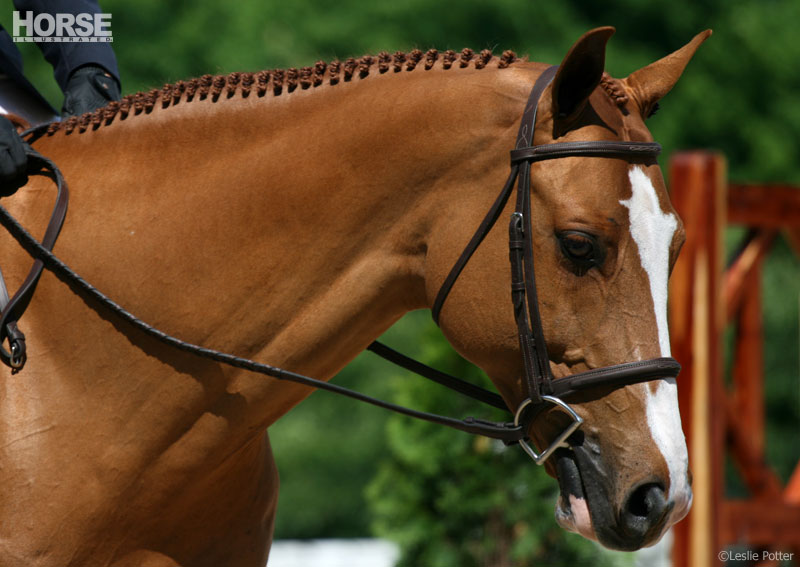
Also Read: English Riding Supply Recalls Wire Mouth Bits for Horses Due to Risk of Injury
The two primary types of bits used today, the snaffle and curb, have been around for hundreds of years in more or less the same form. However, there are many small design differences that can affect the function of a bit and a particular horse’s response to it. Understanding how bits work will help you make better choices for more effective communication with your horse.
How Bits Work?
Bits act on several different pressure points depending on their construction. These pressure points include the corners of the lips, the bars (spaces on the lower gums between the incisors and molars), tongue, chin groove, poll and roof of the mouth.
While bits may seem to have a somewhat scientific basis due to their mechanics, horses often defy logic and simply prefer one type of bit over another for no discernible reason. A young or unfamiliar horse should always be ridden first in a simple snaffle. You’ll need to stay attentive to his cues to find out if the bit is a good match or not.
“Signs of unhappiness include excessively mouthing the bit, repeatedly lifting the bit with the tongue, opening the mouth, crossing the jaw, flinging the head around, shaking the head, swishing the tail, and not accepting an elastic contact with the bit,” says Hilary Clayton, Ph.D., MRCVS. Clayton is the McPhail dressage chair in equine sports medicine at Michigan State University and a respected author, as well as a U.S. Dressage Federation (USDF) gold medalist.
Although the adage is that thicker bits are the mildest, they may not be the most comfortable for every horse, says Clayton. “Some horses have a small mouth, and there isn’t room for a big, fat snaffle,” she explains. “These horses are more comfortable in a thinner bit—within reason of course. I’m not advocating people should ride in very thin bits.”
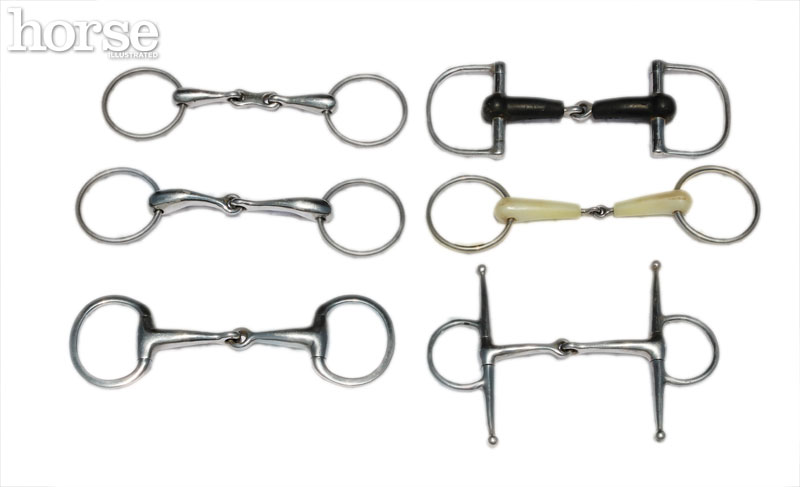
Plain snaffle bits: French link loose-ring; rubber-covered D-ring; single-jointed loose-ring; Happy Mouth loose-ring; single-jointed eggbutt; single-jointed full-cheek.
Smooth Snaffles
A snaffle with a smooth mouthpiece, either solid or jointed, is considered the mildest type of bit and is effective for most horses on the flat.
Snaffles work primarily on the corners of the lips in a lifting action. As the horse becomes more advanced in his training and carries his poll higher with his face closer to the vertical plane, the pressure increases across the lower jaw (bars).
A slightly curved, unjointed (mullen) mouthpiece—particularly if made of flexible plastic or covered in rubber—is mildest of all, but is easier for the horse to lean on. These are often used on young, green horses or for horses with highly sensitive mouths that object to more severe bit action.
“The number of joints affects how the mouthpiece applies pressure,” says Clayton. “A straight mouthpiece with no joints puts even pressure on both bars if equal tension is applied to both reins. If tension is applied to one rein only, then the mouthpiece moves back on that side and moves forward on the other side. Thus the balance of tension in the left and right reins is important. In a bit with a single joint, the joint tends to protrude toward the roof of the horse’s mouth (hard palate) when using the reins. For horses with a low palate, this is painful. The double-jointed bit [French-link or central lozenge] forms a U-shape over the horse’s tongue and avoids digging into the hard palate. Many horses are more comfortable with a double-jointed bit. However, the central link should be short to avoid having the joints situated right over the bars.”
The most common type of snaffle is the loose ring. “The loose ring allows the reins and the mouthpiece to rotate, so it gives the horse a little more ability to move the bit,” says Clayton. This can increase salivation and suppleness for horses that need it.
The danger with loose rings is pinching of the cheeks where the rings feed through the bit, or a ring pulling through the mouth if one rein is used strongly. Having a properly sized bit—one that is big enough for the horse’s mouth—with large enough rings will offset these risks.
An eggbutt ring prevents pinching and keeps the bit more fixed in the mouth, which can be good for a rider with less educated hands; however, this may prohibit more advanced riders from being able to give subtle cues.
A full-cheek snaffle adds turning assistance by acting on the side of the horse’s face when the opposite rein is used. Note that the cheekpieces of these can become hooked on martingale rings and saddle parts when the horse is scratching, which can create a dangerous panic situation. If your horse benefits from this additional steering, a D-ring bit is a much safer choice. Hunter riders often prefer the D-ring look when showing in a snaffle.
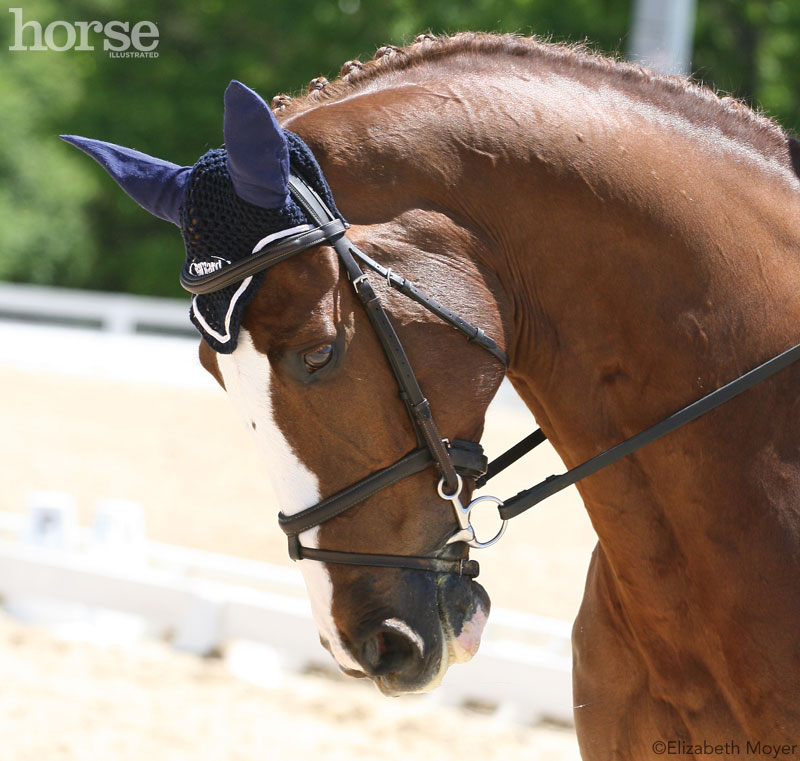
The baucher is a dressage-legal snaffle
The baucher is a type of snaffle that attaches to the bridle by a separate ring above the bit. This adds a small amount of poll pressure, which encourages a high-headed horse to lower his head.
Stronger Snaffles
In addition to the smooth-mouth snaffles mentioned above, there are many other mouthpieces available, generally for the purpose of adding stopping power. While not legal in dressage, they are allowed in jumpers, cross-country, and other disciplines without bit checks. Most of these are legal in hunter competitions, but always refer to your show association’s rulebook to be sure.
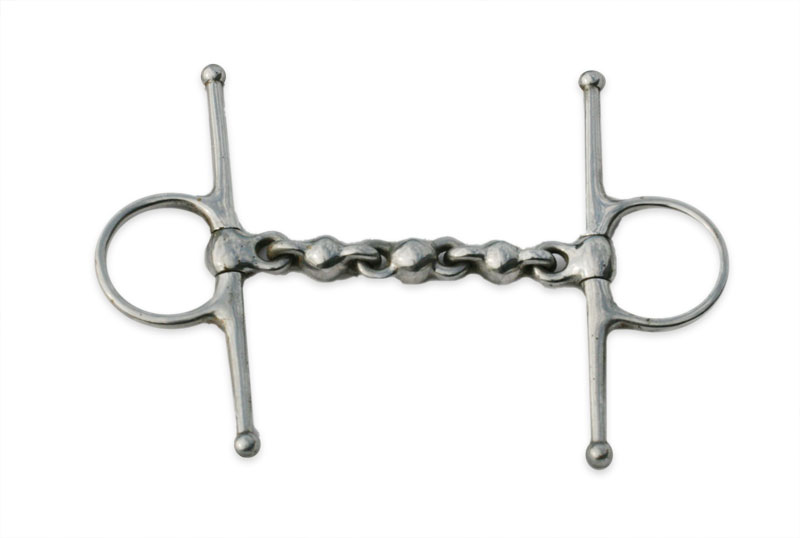
A Waterford mouthpiece prevents the horse from leaning on the bit or grabbing it between his teeth.
The Waterford bit contains many rounded links that look like ball bearings. While it is comfortable and fairly gentle in the mouth, this bit can be good for horses that like to grab or lean on the bit, preventing such tactics with its many joints.
Bits with rollers along the mouthpiece (usually seen on single-jointed snaffles) can also help prevent leaning or bit-grabbing and are not particularly severe.
The Dr. Bristol is another three-piece bit. The center link has a longer, squarer shape than the French-link and is set at an angle to apply tongue pressure for a much stronger effect. Any rider choosing this bit should have very good hands, as its severity is determined by the rider. A fixed ring (eggbutt or dee) helps clarify the on/off nature of the bit’s effect.
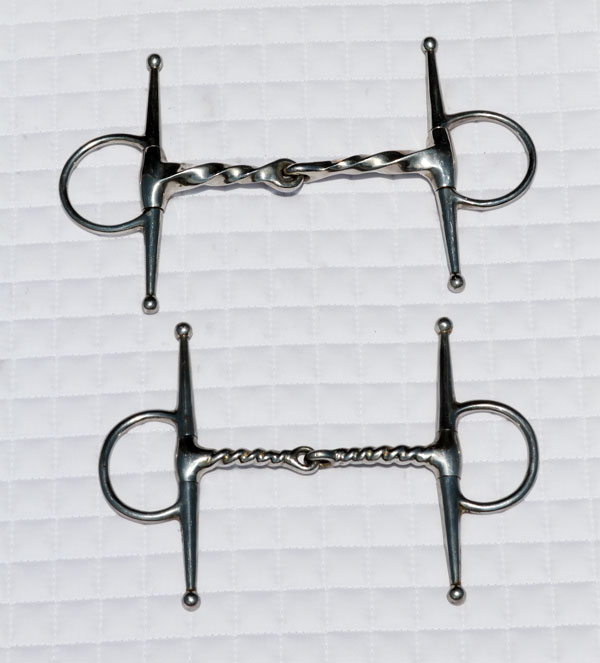
The slow twist (top) and corkscrew (bottom) are two of the more severe snaffles with added braking power.
Slow twist or corkscrew mouthpieces are often used by riders who want or need to stay in a snaffle while adding extra bite to the rein aid.
These can have the effect of deadening the horse’s mouth after a while though, so they should be used with careful consideration.
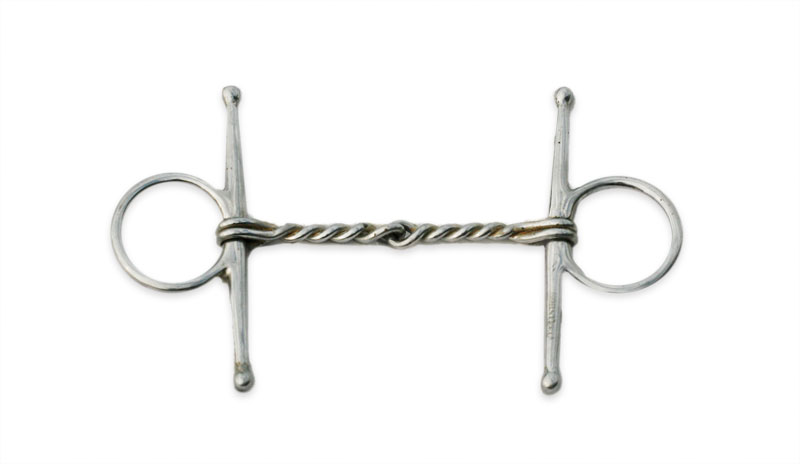
The twisted wire snaffle mouthpiece is very severe and potentially damaging to the horse’s mouth.
Thin, twisted-wire mouthpieces are stronger still, and most bitting experts agree they have no place in good horsemanship. These can tear up or deaden a mouth so that it will never be sensitive again.
One bit that is much more severe than it looks is the double snaffle, sometimes called a “W” bit for the shape it makes when bent. It has two jointed mouthpieces with the joints slightly offset. Often a last resort for runaways, this bit can pinch and damage the tongue and is usually not recommended.
Leverage Bits
While western riders often ride solely in a curb bit on a draped rein, the curb is not used alone in English riding because of the constant rein contact required. Double bridles that use both a snaffle and a curb were once commonplace, but now are only seen in upper-level dressage and saddle seat disciplines.
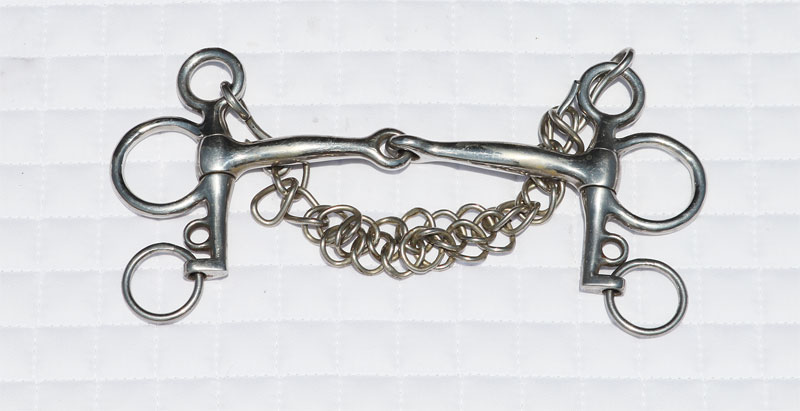
A jointed Pelham bit
PELHAM BIT: The Pelham bit was invented to combine the action of a double bridle into a simpler single bit. The curb chain and shanks on the Pelham help with horses that want to run long and flat, as it applies poll pressure that helps bring the head and neck in, packaging the stride into a rounder shape when needed. The snaffle rein can be used as primary pressure in most situations, with the curb applied as needed.
The Pelham works best with a mullen mouthpiece, although some people with horses that lean on the bit will still reach for the jointed version. The Pelham should always be used with two sets of reins to separate the snaffle’s effect from that of the curb. Using bit converters to ride with one set of reins results in mixed signals for the horse, and is like driving with your foot on the brake all the time, since the curb action is always in play. The action and subtlety of the bit is vastly improved with two reins.
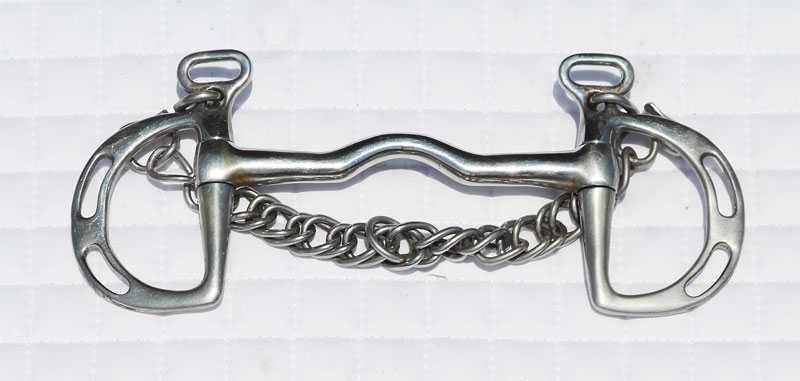
An Uxeter Kimberwick bit has two slots in the rings so the rider can opt for more or less leverage by altering the rein attachment.
KIMBERWICK BIT: The Kimberwick, also called a Kimblewick or Kimberwicke, provides a slight curb action similar to the Pelham but is designed for only one set of reins. A ported, solid mouthpiece is most effective, allowing bar pressure.
Although sold in jointed styles, this design muddies its action. The curb chain and the cheek attachment above the bit allow for some poll pressure and stopping power, and since most of them have two slots in the rings, the reins can be moved down for slightly more leverage. This is a bit where the brakes are always on, so unless safety is at stake, riders should move on from it as soon as possible.
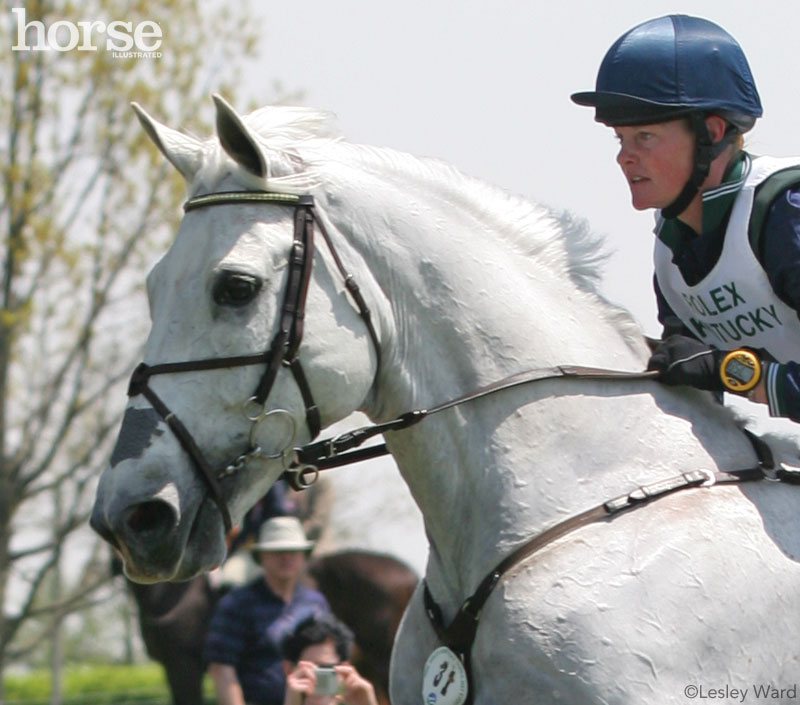
The three-ring bit is a relatively new invention, adding leverage to any of the snaffle mouthpieces.
THREE-RING BIT: A more recent invention is the three-ring, also known as a Pessoa or elevator bit. (Although many label it a “gag,” it is not technically a gag bit.) While bitting theory would say this bit is a muddled mess that shouldn’t work, many riders find it a good solution for horses that get strong to their fences or when galloping cross-country. By combining a gentle rubber mullen or thick, jointed snaffle mouth with leverage, the bit provides curb-type poll pressure to shorten and package the stride. It is recommended that riders use two sets of reins on this bit, one on the snaffle ring and one on a lower ring that only comes into play when needed so that the brakes aren’t on all the time, which can irritate a hot horse.
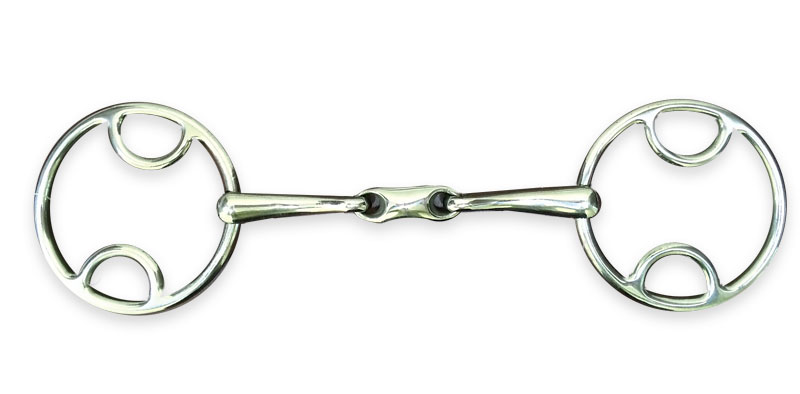
The Beval bit is a modified loose-ring snaffle that allows the rider to apply leverage with the reins.
BEVAL BIT: Another new bit design is the Beval snaffle, sometimes called a “wonder bit,” which uses the idea of a three-ring but minimizes the leverage. Usually seen with a single joint or a double joint with a lozenge, this bit can be a good option for horses that object to the leverage of a three-ring but need a touch more braking power than a regular snaffle offers.
Training Goals
Your goal should be to ride using the simplest bit that you can. If your horse needs something stronger to temporarily teach him not to run at jumps or take off out in a field, it is entirely possible that he will learn from this and be able to switch back to a smooth snaffle at some point. If he gets excessively keyed up only at competitions or outside the arena where your safety would be at risk without some extra brakes, then by all means use them.
Some horses do best when rotating between bits, as they can become dull to the same one over time. Just switching from a French-link to a single-jointed snaffle, for instance, could be a way to freshen up your horse’s response. This is why many riders keep a tack trunk full of different bits, since what works one day may not work the next.
Finally, make sure your horse’s teeth have been checked by your veterinarian if he is having trouble finding a comfortable bit. All horses should have their teeth floated annually to smooth down sharp edges that cause discomfort and bridling issues.
Bit Adjustment
Even the perfect bit for your horse won’t be effective if it’s too big, too small or adjusted improperly. Bits should always be attached to the bridle so they curve over the tongue.
When adjusting a snaffle, it should sit high enough to make two small wrinkles in the corner of the mouth. Bits with curb chains, such as the Pelham, should sit a little lower in the mouth so that the curb chain rests comfortably in the groove of the chin and two fingers can fit underneath it.
English snaffles come in a wide range of sizes, including the most popular 5-inch (standard horse). Quarter-inch increments up to 6 inches or more are available for warmbloods, draft horses or those with a broad muzzle.
Some experts recommend buying loose-ring bits ¼ to ½ inch larger than a D-ring or eggbutt bit so the skin doesn’t get pinched between the rings and mouthpiece.
HOLLY CACCAMISE is the managing editor of Horse Illustrated. After years of catch-riding event horses and foxhunters, she has ridden in almost every bit mentioned in this article.
This article originally appeared in the May 2014 issue of Horse Illustrated magazine. Click here to subscribe!







Thank You, Thank You, Thank You Horse Channels. I alway wanted to find out more about the different bits. Very useful information!!
great info on bits as there are a plethora of bits at every tack store!
Have any advice? I ride an EXTREMELY spunky 7yr gelding who refuses to cooperate, he ignores absolutely everything I ask him to do, hes headstrong and yanks me around wherever he wants, I’ve done more than enough groundwork with him, I’ve tried bitless but he REFUSES to cooperate. Had his teeth checked and everything, hes just TRYING To ignore my aids. Any advice? Thanks! Been riding him in a standard full cheek snaffle.
It’s unfortunate and disappointing you picture a horse contracted past verticle in your article, as if this is acceptable or in any way healthy or ok. The damage it does to the cervical vertebrae cannot be overemphasized, as well as affecting breathing, and total body carriage. There is enough solid scientific evidence of the damage caused by this that you should know better.